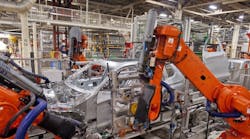The Future of Robotics in Manufacturing: Moving to the Other Side of the Factory
The birth of a BMW sports-activity vehicle begins with a few pieces of metal and the whirs, thrusts and twists of a robot.
Although BMW (IW 1000/37) employs more than 7,000 people at its sprawling factory complex in Spartanburg, S.C., humans are a rare sight on the X5/X6 line in the body shop. There, a battalion of more than 380 robots -- there are nearly 1,000 of them plantwide -- fashions X5 vehicle bodies from 443 separate pieces of metal, performing 237 stud welds and more than 6,000 spot welds on each one, among a flurry of other tasks.
The body shop also boasts BMW's first fully automated hang-on fit line, where robots attach the doors, hoods, hatches and fenders to the vehicles. The "Best Fit" system, which debuted on Spartanburg's X3 line in 2010, automates a process so critical to BMW's quality standards that it once was trusted only to human hands.
"It was the one part of our shop that was almost 100% manual operations," says Herman Adams, the plant's body shop maintenance planner. "The rest of our shop was about 95% automation, so it was a really stark contrast."
While robots now do nearly 100% of the work in the body shop at BMW Spartanburg, it's a completely different story on the assembly lines.
Walk the floor of Spartanburg's two mammoth assembly halls, observes Erik Nieves, technology director for Yaskawa America Inc.'s Motoman Robotics Division, and you see "an army of biology."
Although automation undoubtedly plays a role in vehicle assembly at BMW Spartanburg -- a robotic arm, for example, plunks the sunroof into a hole on top of the BMW X3 -- the final-assembly process is largely the domain of people. And it's no different at any other major automotive plant.
Consequently, Nieves believes that the future of robotics is about finding a way to move robots "to the other side of the wall" -- to the assembly line.
"That's the blue ocean," says Nieves. "How do you do that?"
That Side of the Factory
It's a question that still vexes the industry.
"You can install robots by the trainload, as long as they go on that side of the wall in the factory," says Nieves, referring to the body shop. "That side is this very structured environment. In the body-in-white line, they may change the vehicle platform maybe once a year and not in any substantial way. All of the sheet metal is fixtured. The only obstacles the robots need to worry about are each other."
Conversely, today's robots are ill-suited for the more fluid environment of the assembly line -- where trims and options change frequently, and "dual-arm control" is a prerequisite.
"The constraints [on the assembly line] are much different," Nieves asserts. "For one thing, the work is, by and large, bilateral -- it's two-handed operations. It was built around our human capability, and we are two-handed creatures."
It's not just the lack of humanlike dexterity that makes robots a poor fit for the automotive assembly line. To make inroads into assembly, robots need much more highly developed senses of vision, touch and force.
"Robots on the body line are largely blind. They just have brute force and a memory," Nieves explains. "Robots on the unstructured side have to be much more cognizant of what's happening."
They'll also need to be more intelligent -- which has been a major focus for robotics manufacturers such as Fanuc Robotics America Corp. in recent years.
"Right now, [robots] can see and touch, but you kind of have to teach them what they're looking for and what it is they're going to feel," says Mike Cicco, general manager of distribution sales for Rochester Hills, Mich.-based Fanuc Robotics America. "I can see them getting smarter to the point where they might train themselves how to see or feel something and then remember how it felt so they can repeat it."
To be fair to the robots' human counterparts, it still takes some 450 people to build a vehicle body at the BMW Spartanburg plant, according to the automaker. And there still are a few processes on that side of the factory -- such as brazing, in metal finish -- that require a human touch.
"[Brazing] is something that we haven't been willing to do with robotics, just because it's one of those finesse things," BMW's Adams says. "The amount of money it would take to get a robot with a vision system to do all that -- it really doesn't make sense. It's better to have a trained eye to do that process for us."
Adams says he can't imagine the brazing process being automated anytime soon. However, when it comes to robotics, he adds that you can never say "never."
"I'm a firm believer that any process that we do now by hand can eventually, on some level, be done by robotics," asserts Adams. "It's just a matter of letting the technology catch up with you. And it's not just the technology -- it's the cost of the technology as well."
Democratizing Technology
To be sure, high costs have kept robotics technology out of reach for some manufacturers and for some applications. But thanks to the democratization of technology, the robotics industry is achieving cost breakthroughs by piggybacking off an unlikely source: consumer electronics.
For example, 3-D vision once seemed like a pie-in-the-sky idea for the robotics industry due to the sky-high price of the sensor technology, Nieves points out.
Then came Microsoft's Xbox 360.
"And all of a sudden, all of us in the industrial robot space are going, 'Aha! I finally have a 3-D sensor that doesn't cost five figures,'" Nieves says.
"You're seeing this a lot. Our business would not be able to proceed without riding the coattails of consumer electronics. That's where our volume comes from. That's where our costdown comes from."
For robots to boldly go to places in the factory where they've never gone before -- and to be more accessible to small and midsize manufacturers -- Nieves believes they need to become as easy to use as a DVD player or toaster oven. And that means robotics manufacturers need to "take the programming element out of the way."
"You need to be able to teach [robots] by demonstration," Nieves says. "You can't be picking up a teach pendant and creating a robot program. You can't be dealing in a robot language. That is inaccessible to most of industry."
As for how to achieve that, the aforementioned Xbox 360 might offer some clues.
Using a motion sensor, the Xbox 360's Kinect technology tracks the user's entire body and creates a digital skeleton of the user based on depth data. "So when you move left or right or jump around, the sensor will capture it and put you in the game," Microsoft's website explains.
The Kinect sensor enables full-body gaming -- without the use of a controller.
How could that translate to the factory floor? Well, last August, students at Rensselaer Polytechnic Institute unveiled a robot that can mimic human movement -- via a hacked Microsoft Xbox Kinect sensor. It took the students all of three weeks to write the software.
"As you start seeing more gadgets, as we put more video capability and such on our consumer electronics -- our tablets, our laptops, our cellphones -- we as an industry get to tap into that," Nieves says. "And what used to be a highly expensive, specialized machine-vision setup, well heck, I can just go down to Best Buy and pick up a couple of webcams and poof -- stereo vision."
Meet Your New Team Member
When Fanuc's Cicco thinks about the continuing evolution of industrial robotics technology, he envisions a future that will entail people and robots working "closer and closer and closer together."
That might come sooner than some people think. Fanuc already has developed safety-rated software that limits the speed and position of robots, enabling factories to create robotic cells that are only "as big as the robot actually moves."
"I could see a day when, instead of me putting a part on a conveyor that gets conveyed into a robot's cell, I'm able to just give the robot a part and he picks it up from me and goes along, or that we share the workspace in some way," Cicco says.
Still, for robots to infiltrate the assembly line, they'll have to overcome one other titanic obstacle that has flummoxed the robotics industry for years: creating a seven-axis machine.
"The human arm is a seven-axis machine," Nieves says. "Anytime you ask a six-axis robot to do what people do, you're going to have difficulty."
Adding that one extra degree of freedom would create a robotic arm that is "freely configurable" -- and able to avoid obstacles in the same way that humans do, Nieves says.
When it does happen -- and advancements in sensing technology and intelligence converge -- Nieves predicts we'll view robots much differently than we do today.
"Today in 2012, we think of robots. By 2020, nobody will be talking like that," Nieves says. "They're going to be production partners. They're going to be your collaborators."




